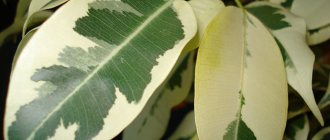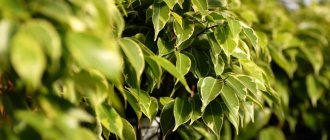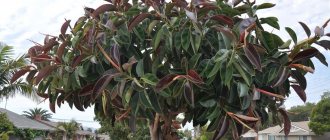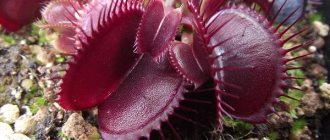Along with geraniums and balsams, rubber ficus is a popular inhabitant of window sills. It is believed that the perennial with large (up to 30 cm in length) dark green leaves and red stipules brings prosperity to the family.
The name of the culture speaks for itself. Europeans have long used the shoots of the plant to produce rubber. That's why some call ficus rubber tree or elastica.
Species diversity
More than 1000 species of ficus grow in their natural habitat. In indoor floriculture, the most popular varieties are Robusta, Tineke, and Belize. Despite their close relationship, each species has its own characteristics and nuances of content.
What does the rubber ficus look like, what family does it belong to?
Ficus elastica is considered a popular plant that is used for decorating rooms. The plant belongs to the Mulberry family, native to India and Indonesia.
Ficus Elastic in a pot
Common varieties
The following varieties of rubber ficus are distinguished:
- Robusta. It is distinguished by thin leaves of light green color, which darken to dark green over time. The plate size can reach 50 cm in length and 20 cm in width. A characteristic difference of the subspecies is the pronounced central vein on both sides.
- Melanie. This plant has glossy leaves, their shade is rich green. In bright light they take on a red tint. The leaf blade is wide, the tips are slightly bent back. Unlike Robusta, it grows small - up to 50 cm.
- Burgundy. Ficus has purple leaves that reach 30 cm in length and 10 cm in width. The central vein is red in color and not very pronounced. The cap of the flower is bright red, the petiole is pink.
Interesting! Ficus variegated is also very popular.
Medicinal properties
What are the beneficial properties of ficus:
- Purifies the air from harmful fumes and converts them into amino acids.
- Releases active substances that increase performance and restore sleep.
- It has a beneficial effect on the energy of a living space - it helps cleanse the surrounding space of anger and anxiety.
- Decorates the interior with beautiful green leaves.
The leaves of the plant can be used to treat many skin pathologies.
History of appearance
Ficus rubber, or ficus elastica, belongs to a species of plants of the Mulberry family. He arrived in Russia from northeastern India and Indonesia. In these countries, its dimensions were more impressive - up to 30 meters in height.
Rubber plant on the window
It received the addition of “rubber-bearing” to its name for obvious reasons. The milky sap of the plant contains isoprene. It produces rubber, which is used to make rubber.
Tineke
Among the characteristic features of the variety is a two-color leaf blade. In the photo of the rubber ficus Tineke, it is clearly visible that the middle of the leaf is green, and the edges are framed by a white-yellow border.
Considered a capricious culture. If not properly cared for, it loses its decorative effect.
Why do ficus leaves fall off?
If the plant gets rid of only the lower leaves, this is a natural biological process. Otherwise, you should correctly determine the cause of this problem. There may be several options:
- Excess moisture in the soil or excessively dry substrate. If the reason lies in improper watering of the pet, irrigation should be carried out moderately. The bush is covered with film to create the effect of a mini-greenhouse. If the soil in the pot remains waterlogged despite all efforts, the tree is replanted.
- Lack of sun rays. In the absence of natural light, the plant can be provided with artificial lighting.
- The presence of a draft in the room, especially a cold one. The green beauty cannot tolerate sudden changes in temperature. If not properly cared for, rot may develop. Not only does the foliage get rid of, but there is also a clear softening of the stem, and liquid continuously flows out of it. It is not possible to save such a plant. It needs to be thrown away urgently and the space where the pot was located must be thoroughly disinfected.
- Incorrectly performed transplantation. It is recommended to water the soil with Zykron. The concentration of the product is four drops per liter of water. Keep the soil moist. The same treatment is appropriate for problems caused by errors in the irrigation mode.
- The air is too dry. This may be one of the reasons for the sudden loss of foliage. Since this often happens after turning on the central heating system in the autumn, it is best to spray the leaves or install a humidifier as a preventive measure.
To speed up the process of development and growth of new leaves, your green pet can be treated with Epin solution (2 drops per liter of water). Spraying is carried out once a week and always at night. After all, under the influence of sunlight, the product rapidly loses its properties. Treatment is carried out for a week, followed by a break of the same duration. Then the course can be repeated.
If no measures have had the desired effect and the ficus is in a deplorable state, it is worth digging it up and checking the condition of the root system. Rotten, wrinkled or dry branches are removed to a healthy area. The sections are dusted with charcoal powder. You can also use activated. The pet is moved to a smaller pot. The substrate is completely replaced with a new one.
Know! Even if the indoor beauty is left completely without foliage, it will be able to recover. Proper care will save the situation.
Belize
It is a variegated species, differing from the previous species by pink spots on the foliage. It will not cause many maintenance problems if you place the pots in a well-lit place.
Signs and superstitions
According to ancient beliefs, ficus is considered a flower that brings discord to relationships. In the house where it sprouts, quarrels, showdowns and misfortunes often occur.
Important! It is believed that ficus in the house spoils the character of men: they become aggressive, hot-tempered and overly jealous.
Elastic ficus is a beautiful ornamental plant. It not only decorates the interior of the house, but also helps clean it. According to research, the flower contains active components that convert harmful fumes into amino acids and have a positive effect on the human body.
Watering
The frequency of watering depends on the time of year and the established temperature conditions. In summer it is allowed to water the flower twice a week, in winter - once.
One of the important rules for growing rubber ficus at home is moderate watering. Flooding is unacceptable - this can cause the tree to shed its leaves. It is better to use soft, settled water.
Features of the plant
The name rubber ficus is due to the fact that it has thick sap inside that contains rubber. Ficus, growing in nature, is revered by Buddhists as a sacred crop. It can grow up to 30-40 meters and expands well due to aerial roots. Because of these roots, locals call it the “snake tree.” The leaves of the plant are large, leathery and rich green in color. They are oval, tapering to the tip.
Flowering ficus rubber plant
Interesting!
In the old days, Ficus rubber was grown en masse to produce rubber.
The flowers are simple and not particularly beautiful. Flowering occurs if the plant is pollinated by certain types of insects, so it occurs when grown outdoors or in the garden. The fruits are almost round, up to a centimeter in diameter, and look like inedible figs.
Outside hot regions, rubber ficus is grown primarily as an ornamental plant. In apartment conditions, it rarely grows more than 200 cm. If the ficus has grown too large, you can always trim it, then it will stop growing upward and begin to grow leaves. But it’s worth considering that it rarely produces lateral pagons in indoor conditions, so it’s important to be able to shape it in order to get a beautiful crop.
Lighting
A window facing west or east is an ideal location. In this case, the perennial receives a sufficient amount of bright, diffused light.
Elastic also tolerates shaded areas well. In the shade, the plant may develop a little slower than in the light, but this does not affect the general condition.
When and how does it bloom
Ficus Robusta rubber - planting and care at home
Ficus macrofolia produces beautiful and fragrant inflorescences.
Types of flowers
The plant blooms with small buds of a light shade. Indoor types of ficus are not particularly beautiful when flowering.
Flower shapes
The inflorescences are oval in shape, the leaves in buds are pear-shaped.
Flowering period
The formation of inflorescences can be observed in late spring or early summer, when the plant crop begins to branch. However, indoor breeds can rarely be made to bloom luxuriantly. It can only be seen on those ficus trees that grow in botanical gardens.
Changes in care during the flowering period
There should be no fundamental changes in care when buds appear. If the plant begins to bloom, it is permissible to water the plant a little more often than usual.
Humidity
In summer, daily spraying is carried out from a spray bottle. Once every 2-3 weeks, the leaf blades are cleaned of dust and dirt with a damp sponge.
Elastica responds well to a warm shower, while the soil in the pot is covered with film. In winter, they usually limit themselves to wiping the leaves.
How to care at home?
Ficuses are whimsical plants. They require proper care. If something is done wrong, the leaves will begin to turn yellow and fall off. This will also negatively affect the tree’s immunity and significantly increase the likelihood of flower disease.
In order for the plant to feel good and develop normally, you need to know how to properly care for it. It is worth considering this issue in more detail.
What soil is suitable?
These plants require loose soil. If it is dense enough, then the roots will not be able to develop normally and receive the necessary microelements.
Therefore, it is necessary that the pot contains the following contents:
- expanded clay as drainage;
- loose soil;
- coarse sand.
Important. It is necessary to loosen the soil after each watering, but this must be done carefully. The tree has a developed root system, so there is a risk of damage.
Watering
There are special watering rules that should not be neglected:
- You can water only with warm water, which must settle. If the water is cold or there is a large amount of bleach in it, the ficus can quickly die.
- 30 minutes after watering, excess water must be removed.
- Watering is carried out 2-3 times a week, when the soil dries 2-3 cm.
- Once a month you need a warm shower in the bathroom.
- You need to spray the ficus with a spray bottle twice a day. The procedure is carried out in the morning and evening. It is forbidden to do this during the day, as the leaves can get burned.
Important. Untimely and excessive watering provokes yellowing of the leaves, so you need to pour a little water.
Fertilizer
Ficus plants should be fed from March to August, when they have a period of intensive growth. In this case, it is necessary to use mineral fertilizers that contain the following elements:
- potassium;
- phosphate;
- manganese.
They are necessary for the rapid formation of green leaves and rapid growth.
Important. Fertilizers must be used as indicated in the instructions. But the first time you use it, you need to greatly reduce the recommended dose in order to study how suitable the selected fertilizer is for a particular plant.
You can also add organic fertilizers, but in small quantities. They contain large amounts of ammonia, which can cause root burn. They must be added exclusively in liquid form.
Is it necessary to loosen the soil?
Yes, this needs to be done every time after watering. In this case, loosening occurs as follows:
- First check how dry the soil is.
- Then add water for irrigation.
- Next, using a blunt object, you need to slightly loosen the soil so as not to damage the roots.
If this is not done, the ground can become very hard. Then the roots will be pinched and will not be able to take nutrients from the soil. As a result, the tree will begin to die from a lack of essential microelements.
Trimming
Ficuses must be pruned, forming a crown and stimulating growth in the necessary parts. There are several rules to follow:
- All lower branches that appeared for some reason must be deleted.
- Skeletal branches are cut to 2/3 of their growth (per season).
- All dry and diseased shoots must be cut off.
Important. Branches must not be broken; they are cut with pruners or a knife. The tool must first be treated in an alcohol-containing solution, and after completion of the work, all cut areas must be treated with activated carbon.
Transfer
The tree must be replanted every year, and after it turns 5 years old, every 3-4 years. In this case, you need to buy a pot 3–4 cm larger in diameter. You don't need to buy a big one right away.
Here's how the transplant happens:
- Expanded clay is placed at the bottom of the pot.
- Earth and sand are poured on top.
- The ficus is removed from the pot and cleaned of soil by tapping, but without using water.
- Carefully examine the root system for the presence of rot (if there is any, it needs to be removed).
- The plant is replanted, soil is added and it is compacted a little.
Important. Watering should be done only a couple of days after transplanting. Yellowing of leaves and their falling off are natural processes at first, as the ficus has experienced stress.
Soil and feeding
For ficus, organize a substrate consisting of equal parts of turf, leaf and sandy-peat soil. Fertilizer is applied only during the period of active growth.
It is recommended to alternate organic and mineral fertilizers. In flower shops you can purchase liquid nitrogen-containing fertilizers for indoor crops.
Suitable soil and pot
To plant ficus, you can purchase ready-made soil intended specifically for this plant. You can also collect the substrate yourself. Its composition depends on the age of the specimen.
For young people, the best ingredients are in the following proportions:
- Sheet peat (1)
- River sand (1)
- Humus (1)
For adults, a slightly different composition is needed:
- Leaf humus (1)
- Turf (1)
- River sand (1)
- Peat land (1)
To obtain looser soil, you can additionally add expanded clay or charcoal to it.
There are no specific requirements for choosing a pot. The main thing is that the root system fits into it. There should not be too many drainage holes. Any material will do: from plastic to ceramics.
- House plants
Growing indoor spurge: rules for keeping and caring for exotic plants
Transplantation and propagation
Young specimens are replanted every year, older trees - every 3 years. The new pot must be larger than the previous one, and drainage must be placed at the bottom.
- Development of technological production regulations
- Phloxes in personal plots
- Ficus transplantation: step-by-step instructions on how and when to replant various types of indoor ficus plants (135 photos and videos)
Both classical transplantation and transshipment with an earthen clod are allowed.
Reproduction of rubber ficus is possible by leaves, cuttings, seeds and layering. In the first case, they take a leaf blade with a stem.
For quick results, root in willow water. For the seed method, material in advance. The seeds are soaked for 24 hours in a stimulating solution, after which they are sown in a greenhouse. Germination temperature - 30 degrees.
The easiest way to get a new plant is cuttings. To do this, ficus cuttings up to 15 cm long are cut from the mother bush obliquely. 1 pair of leaves is left on the stem, the cut is washed to remove the juice. Place the shoot in a glass of water and wait for root formation to begin.
Problems with keeping ficus trees
Gardeners may encounter the following problems when growing ficus plants.
Falling leaves. The probable cause is waterlogging of the soil. To eliminate the problem, you need to reduce the intensity of watering and increase drainage.
Falling of lower leaves. This is a natural process, no additional measures are needed.
Wilting, curling of leaves. Perhaps the room temperature is not high enough for the ficus. The plant needs to be moved to a warmer place. Sometimes it is enough to remove it from the windowsill if it was there.
Brown leaf tips. The reason may lie in dry, insufficiently humid indoor air. Spraying the ficus and increasing the humidity will solve this problem.
The new leaves are small and the shoots are thin. The plant does not have enough light or nutrition. It is necessary to increase the illumination and fertilize.
Diseases
Diseases of rubber ficus occur as a result of errors in care or the appearance of insect pests. Common cases:
Yellowing of leaves, presence of brown spots. There are a number of reasons for this: drafts, floods, drop in temperature. Remove dry leaves and reconsider the conditions.
Crown shrinkage. Most likely, elastica lacks nutrients. There are 2 solutions - add fertilizing or replace the old, depleted substrate in the flowerpot with a fresh one.
Dropping leaves. If the phenomenon occurs periodically, then there is no need to panic. This is the norm for ficus. Otherwise, pay attention to the lighting.
Insect pests. If you notice sticky whitish spots or streaks on the leaves, then a possible source of trouble is a scale insect. It sucks the juice out of the plant, gradually weakening it.
- Ficus is turning yellow - what to do? Main reasons, tips for restoration and treatment of indoor ficuses (110 photos and videos)
- Sewage pumps: types, how to choose the right one
Ficus bonsai: secrets of growing and care at home. 140 photos of ficus varieties and video instructions for selecting conditions for growth
The only option to combat it is the use of chemical insecticides. This also applies to mealybugs and spider mites.
How fast does it grow?
It all depends on the type of ficus and the conditions under which it is located. Growth usually takes place very slowly. So, in 5–7 years the plant grows to about one meter in height. However, for experienced gardeners it can achieve such results in 2–4 years. It is important to create optimal conditions for the plant and choose the right fertilizer. Then it will be able to grow quickly.
Here are a few rules for successfully growing ficus trees:
- Protect them from drafts.
- Place in a room with good lighting.
- Do not allow direct sunlight to hit the leaves.
- Water and fertilize on time.
Benefits and harms
Ficus is a natural filter. Its leaves actively purify the air by absorbing harmful substances. But people who have problems with the respiratory tract or suffer from asthma are not allowed to hold the elastic. The fact is that rubber can cause coughing and suffocation. In rare cases, an allergy to ficus occurs.
What diseases and pests are you susceptible to?
Ficus plants have weak immunity, so they are susceptible to attacks by insects and various diseases. What insects can infect the plant:
- aphid;
- mealybug;
- spider mite;
- thyroid gland.
However, you can get rid of them with the help of modern poisons. As for diseases, they can be viral or bacterial in nature. Most often we encounter gray rot, rust and root rot. Experienced gardeners can detect the problem early and use fungicides. For beginning gardeners, the recommendation is to remove the affected areas and treat the cut with activated carbon.
Photo of ficus rubber plant
Ficuses in winter - care features
- The plant should not stand in a draft.
- It is important not to limit the plant’s light and maintain sufficient air humidity, but at low temperatures, it is better to refrain from spraying and place a container of water next to the plant.
- During the winter heating period, the ficus should be protected from heating devices.
- Reduce watering, but do not allow the soil to dry out completely. Drying is permissible to a depth of about half the pot (versus 2-3 cm from the surface in summer).
Distinctive features and varieties
The world knows about 2 thousand species of ficus, but only 1% of them are used in home floriculture. All varieties are unique in their own way, beautiful, have characteristic features and colors, but caring for them is quite simple.
The most popular are the compact species with large leaves. They are grown to decorate spacious rooms and create a cozy atmosphere.
Robusta
A tree with dark green, shiny, dense leaves 10–15 cm wide and up to 20 cm long. The trunk is thick, smooth, and has few branches. Robusta is unpretentious in care and has high levels of air purification, for which it is in demand as a pet.
When maintaining a ficus, it is necessary to trim the top, otherwise the stems will stretch and lose their attractiveness.
Tineke
A variegated variety with green, stiff leaves with a cream-colored edge and olive streaks along the edges. Their maximum length reaches 25 cm; a thick yellowish vein runs through the center. Petioles and stipules are brown.
Tineke is considered one of the most capricious varieties of ficus and needs proper lighting, watering, frequent spraying and warmth.
Melanie
This variety is the most compact; it grows not upward, but in breadth, creating lush bushes. Melanie's ancestor was the Decorah species, which mutated over time and made it possible for breeders to develop a new variety.
Externally, the variety is very similar to Robusta, but its leaves are smaller and the bush is more branched. The characteristic color is dark green, monochromatic, burgundy on the inside and on the stipule. Universal soil for flowers is suitable for replanting. Moderate watering is required, when the soil dries out by 2 cm. To maintain the shape of the bush, the crown is pruned in spring.
Abidjan
A slender, handsome evergreen with a powerful stem and large, fleshy leaves has become a regular fixture in boring offices. The height of the Abidjan variety reaches one and a half meters, allowing you to grow the flower in wide pots on the floor.
Caring for rubber plants is undemanding and is suitable even for a novice gardener. The green part is sprayed and wiped with a damp cloth to remove dust.
Belize
Thanks to the mutation ability of ficus, a new variegated variety, Belize, was obtained in greenhouse conditions. Externally, the plant is no different from its fellows, except for color. Along the contour of the leaf blades, in addition to cream and olive shades, there are pink and burgundy, and a wide dark pink vein runs through the center.
Dense, elongated oval leaves with a pink coating look unusual and original compared to other plants. Like all variegated plants, Belize is demanding in care, especially in high-quality soil and lighting (with a lack of light, the color fades and disappears).
Black Prince
This species has been grown indoors for a long time and is quite popular. The demand for the Black Prince is due to its unpretentiousness and ability to change the shade of green depending on the lighting of the room. In the morning, the color is dark green, and in the afternoon it is darker, almost black; the burgundy stipules, which are clearly visible against its background, add great effect.
The variety is distinguished by rounder and wider leaves with a glossy surface. Caring for crops is a real pleasure and even a child can do it. The plant has strong immunity, tolerates drought well and quickly adapts after transplantation.
Mix
For greater expressiveness, several varieties of crops are planted in one pot. This makes it possible to get an original and spectacular flower with an unusual color. The mix is variegated and monochromatic, with hard, elongated leaves. The height of the bush depends on the conditions of its maintenance, but generally does not exceed 150 cm. To maintain its decorative qualities, the plant is placed on a windowsill or near a light source.
A wide range of species makes it possible to experiment and grow several tropical trees in the house at once, especially considering their ability to purify the air and create a favorable environment. Superstitious people believe in signs associated with improving the aura in a room and getting rid of negativity in the presence of a ficus. This fact is explained by the ability to absorb toxins and harmful substances with the leaves of the plant, like sponges, and neutralize radiation.
Growing conditions for indoor ficus elastica
Soft but bright light and warmth are all that ficus elastica needs. If you don’t experiment with distance from the window, it’s quite difficult to make a mistake with choosing a place.
Lighting and placement
Ficus rubber prefers diffused, soft light. Variegated decorative forms are more light-loving and lose their patterns even in light shading. “Pure” green-leafed elastics adapt well to average light levels. But at the same time, all varieties equally slow down growth and are more prone to shedding the lower leaves even in slight partial shade. Ficus plants can be placed away from the window only if the latter is oriented to the south, focusing on conditions similar to eastern window sills.
If the size allows, it is advisable to move the ficus elastica to a more sunny place for the winter.
Temperature and ventilation
This is a heat-loving ficus, for which even in winter you should not allow temperatures to drop below 13 degrees (the plant can withstand 5 degrees of heat, but only with a completely dry substrate).
In summer, Ficus elastica tolerates heat well, up to 30 degrees, although stable room conditions of 20 to 25 degrees remain the best option. In winter, it is advisable to lower the temperature slightly, to 16-20 degrees Celsius.
Ficus elastica does not like changing place, rearranging, or frequent turning. And any sudden changes in conditions. It should not be placed near heating devices or in a draft. Sudden changes in temperature can cause leaves to drop.
Ficus rubber prefers diffused, soft light.
Diseases, pests and problems in growing elastic
In unfavorable conditions, especially with low air humidity, elastics can be affected by spider mites or mealybugs. Scale insects love them, and nematodes always cause catastrophic damage. At the first signs of damage, you need to start treating with insecticides as soon as possible.
With any sudden change in conditions, ficus elastica can shed its leaves. Overwatering threatens rot.
Ficus elastica is easily propagated by air layering.











